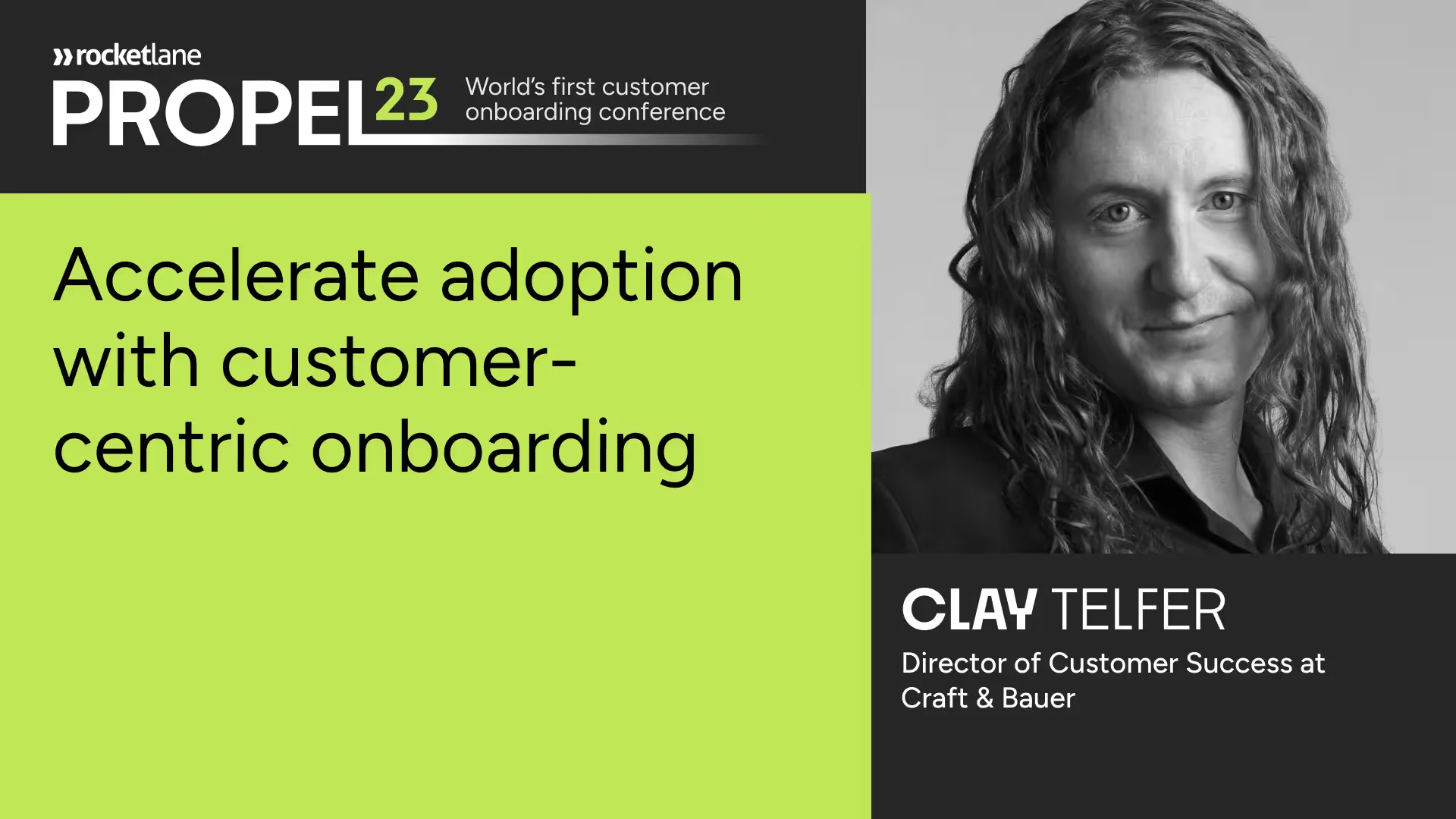More resources:
- Learn from Kristi Faltorusso how to create a customer-centric onboarding program.
- Discover a five-point customer onboarding framework that keeps your customers in the spotlight.
- Know more about the four-pillar approach to customer onboarding to provide the best experience for your customers.
- Emilia D’Anzica reveals the six key pillars for building a customer-centric culture for PS teams.
At Propel23, Clay Telfer, director of Customer Success at TutorMe, sheds light on customer-centric onboarding and shares some action items for implementing it.
In this session, Clay talks about:
- The principles of customer-centric onboarding
- How to implement a customer-centric onboarding
- A real-life example of a customer-centric implementation
Principles of customer-centric onboarding
Clay applied three customer-centric onboarding principles in companies he worked with, yielding impressive results like:
- 36% reduction in adoption time for TigerLeads Solutions
- 25% lowered churn at Bambee HR in six months, and
- 11x expansion in TutorMe's customer base
Here’s a deeper look at these principles and their implementation.
1. Your onboarding should focus on what makes your clients successful
Even though it sounds obvious, some firms lack this critical understanding. They primarily emphasize teaching customers how to use their product or service during onboarding, rather than focusing on helping them achieve success. However, it is crucial to differentiate between these two concepts.
While your onboarding process may incorporate instructions on product usage, the primary objective should always be to guide clients toward success as they see it.
To cultivate a customer-centric approach, ask yourself, “What is the key indicator that a customer will be successful with our product/service?”
2. Define what success looks like for your customers
The second most important thing is to get the customer to define what success looks like. This simple step significantly reduces churn in businesses and makes renewal conversations easier.
Start your onboarding call with your customer like this:
“I want to make sure you're so successful that you can't wait to renew your contract next year. What would you need to see to make that happen?”
Once you possess this information, there is no need to depend on the client to determine their level of success. Instead, you can assess the client's success by monitoring their progress towards achieving their goals.
3. Users want more training on features that deliver value to them as they see it
There is a demand among users for more training on features or capabilities that bring them value. This may mean reducing the amount of technical training provided during onboarding.
Companies tend to cover everything during onboarding as they worry that customers may not participate in future meetings or training sessions. However, this approach, where customers fail to perceive value in the initial stages, only worsens the situation.
Imagine a customer who receives sufficient technical training but lacks success training. After a month, when it’s time for their first success call with your customer success manager, they’d made little progress towards their goal. It’s unlikely that they will prioritize attending the meeting in this scenario. Even if they do, it will be an uphill battle to change their perception of the product since their initial impression is that it does not work.
Now, consider a client who has already made significant progress towards their goals because they were taught how to be successful during onboarding. They will eagerly anticipate their success call and be eager to learn about more advanced features. In fact, they’d be more likely to reach out for help even before the first meeting.
Reducing technical training and increasing success training for customers decreased the adaption time for TigerLead Solutions by 36%. After experiencing early success, clients began to emphasize the full adoption of their system by their agents, something they had not prioritized during previous less successful periods.
Implementation of customer-centric onboarding
1. Identify the three most critical elements of success with your product.
2. Build a new process from scratch, centered around ensuring every client does those three things from Day One.
There are a few reasons to opt to start from scratch. The current setup is likely designed to focus on teaching specific features or how to use certain parts of the system or product. Attempting to adapt that existing framework for a completely different purpose would not be ideal. Instead, when dealing with something important, it can be more effective to create an entirely new framework centered on teaching individuals how to succeed.
3. Start your final onboarding call by asking the customer what success looks like to them
If you're unsure about how to access the question regarding the client's definition of success, here are two script suggestions to initiate your final onboarding call:
- "Today I'm going to make sure you've got everything you need for this to be a huge success. Before I get started, is there anything you wanted to discuss right away?"
- "I want to make sure you are so successful that when your contract is up next year, you can't wait to renew it. What would you need to see to make that happen?"
By incorporating these lines at the beginning of your final onboarding call script, you will already have an advantage over most of your competitors.
4. Schedule and plan your first success call in consultation with the customer
The timeline in which you schedule your first success call may vary based on several factors such as your product and your level of engagement with customers. As a general rule, scheduling the call after one month is recommended.
On the success call, emphasize that you will provide more strategies and training based on their progress toward their goals.
5. Reboot unsuccessful customers.
Once all the necessary preparations are in place, your next step is to identify the customers who are not currently successful.
Reach out to all of them and propose a meeting to discuss how you could assist them in achieving their goals. Guide them through your revamped onboarding process, introducing strategies for success.
In cases where it may not be feasible to reboot all customers, narrow your focus on customers above a certain level, or in a certain tier.
A real-life example of a customer-centric implementation
TigerLead Solutions relies on a unique approach that centers on providing leads and a CRM to their clientele, consisting of real estate agents. This approach differs from the conventional inbound strategy common in the real estate industry.
As a crucial part of enhancing their customer onboarding process with a focus on customer-centricity, TigerLead Solutions initiated an analysis of their clients’ (real estate agents) utilization of their platform. The objective was to better understand the factors contributing to their success. They identified three key success factors as part of this analysis.
Firstly, it was established that each lead required a minimum of 10 interactions from the agent within the initial two weeks. Secondly, agents must be held accountable for actively engaging with these leads. Lastly, some of these interactions needed to be conducted through text messaging.
Subsequently, TigerLead Solutions developed a structured onboarding procedure to ensure the agents adhere to these three principles. To reinforce the principles, TigerLead Solutions consistently emphasized them and furnished sample outreach cadences as guidance, complete with specific recommendations for communication channels and timing. Furthermore, they provided informative flyers for agents to reference, ensuring comprehension of the three elements and their practical implementation.
During the onboarding phase, TigerLead asked agents about their criteria for defining success and sustaining motivation in their partnership with the company. For instance, an agent might express satisfaction if they received 10 multimillion-dollar leads monthly, with 15 of these leads resulting in property showings and regular logins to the platform.
Four weeks later, TigerLeads carried out a follow-up success call to assess progress. During the call, TigerLead Solutions focused on revisiting the goals outlined by the agents. For instance, they might say, "Vicki, based on your goals, you received 14 multimillion-dollar leads in your first month, which is fantastic. You showed homes to 13 clients, slightly below your target, but this is common in the early stages. 70% of your agents logged in five days a week, which is positive. However, it was noticed that 20% only logged in once a week, so we can work on improving that. Overall, it seems like a great start. Does it feel the same to you? Is there anything we may have missed?"
This approach facilitated alignment and adjustment of goals according to the agent’s perception of success. If the agent expressed dissatisfaction, it signaled that the goals had not been accurately set, prompting collaborative efforts to establish appropriate objectives. Once the right goals were in place, assessing the agent’s success no longer needed TigerLeads’ direct input.
TigerLeads also used this follow-up success call to introduce and expand upon advanced features.
This customer-centered approach extended beyond the onboarding phase and persisted throughout the entire journey, playing a pivotal role in curbing churn.






















.webp)